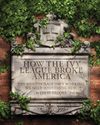
M
Most of the people who come to Blandford Cemetery, in Petersburg, Virginia, come for the windows— masterpieces of Tiffany glass in the cemetery’s deconsecrated church. One morning before the pandemic, I took a tour of the church along with two other visitors and our tour guide, Ken. When my eyes adjusted to the hazy darkness inside, I could see that in each window stood a saint, surrounded by dazzling bursts of blues and greens and violets. Below these explosions of color were words that I couldn’t quite make out. I stepped closer to one of the windows, and the language became clearer. Beneath the saint was an inscription honoring the men “who died for the Confederacy.”
Outside, lawnmowers buzzed as Black men steered them between tombstones draped in Confederate flags. The oldest marked grave at Blandford dates back to 1702; new funerals are held there every week. Within the cemetery’s 150 acres are the bodies of roughly 30,000 Confederate soldiers, one of the largest mass graves of Confederate servicemen in the country.
Diese Geschichte stammt aus der June 2021-Ausgabe von The Atlantic.
Starten Sie Ihre 7-tägige kostenlose Testversion von Magzter GOLD, um auf Tausende kuratierte Premium-Storys sowie über 8.000 Zeitschriften und Zeitungen zuzugreifen.
Bereits Abonnent ? Anmelden
Diese Geschichte stammt aus der June 2021-Ausgabe von The Atlantic.
Starten Sie Ihre 7-tägige kostenlose Testversion von Magzter GOLD, um auf Tausende kuratierte Premium-Storys sowie über 8.000 Zeitschriften und Zeitungen zuzugreifen.
Bereits Abonnent? Anmelden

The Dark Origins of Impressionism
How the violence and deprivation of war inspired light-filled masterpieces

The Magic Mountain Saved My Life
When I was young and adrift, Thomas Manns novel gave me a sense of purpose. Today, its vision is startlingly relevant.

The Weirdest Hit in History
How Handel's Messiah became Western music's first classic

Culture Critics
Nick Cave Wants to Be Good \"I was just a nasty little guy.\"

ONE FOR THE ROAD
What I ate growing up with the Grateful Dead

Teaching Lucy
She was a superstar of American education. Then she was blamed for the country's literacy crisis. Can Lucy Calkins reclaim her good name?

A BOXER ON DEATH ROW
Iwao Hakamada spent an unprecedented five decades awaiting execution. Each day he woke up unsure whether it would be his last.

HOW THE IVY LEAGUE BROKE AMERICA
THE MERITOCRACY ISN'T WORKING. WE NEED SOMETHING NEW.

Against Type
How Jimmy O Yang became a main character

DISPATCHES
HOW TO BUILD A PALESTINIAN STATE There's still a way.